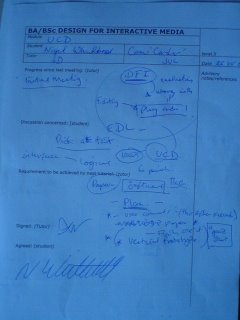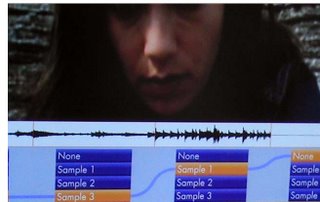 Product Interface Interaction
Product Interface InteractionThe product that
I have chosen to review is JV
C's GZ-M
G26 Ever
io Hard Disk Camcorder. It is portable (handheld and compact), has a multimedia interface (display screen), and has some features that could be redesigned or features that could be introduced.
Description and FunctionalityThe product itself is a handheld digital camcorder with a built in 20GB hard drive. You can also be use it as a digital camera to take still images. It is built out of a strong black and gunmetal plastic (as are the buttons, knobs and levers) and the lens housing is made out of aluminium.
Shooting is simple. Just flip

out the LCD monitor screen, select the camera or video mode and press the record button. All photos and video are stored on the large built-in 20 GB hard drive which can hold between 290 to 1500 minutes of video and up to 9999 still images depending on the compression rate and picture

quality.
Judging by its online brochures it's intended users are families in there 20's and 30's who are computer literate and willing to learn simple editing software to produce their own DVDs.
Apart from taking video and stills you can use the camcorder to view these image in its LCD screen or hook it up to a TV monitor or via saving them to a PC. You can re-order the scenes or delete them and add special effects to the playback of the video.
Concerning the environment within which it can be used its mainly designed for daylight conditions but it does contain a white LED and a night scope for darker conditions. You can also buy tripods, flashguns and a marine case for under water shooting up to 30 metres.
To access the functions of the device you mainly use the menu button, the index button and the control lever to move around the display and interact with the onscreen interface menus. In terms of m

ultimedia you can view what
you have recorded on TV, copy it to PC to edit fully from there, or you can burn DV
D’s directly onto a “share station DVD burner
” and view the footage on any device that plays DVD’s.
Interface DesignThe interfaces look and feel is typical of most camcorders with various symbols, battery levels and other information on top of the footage on screen. But when you press the main menu button th

e interface is more like a mobile phone menu with animated icons next to text descriptions. Even the control lever, which you use to navigate up, down and left, right through the on screen options is reminiscent of the joystick controls on many mobile phones, especially Sony Ericsson models.
In play mode as opposed to the record mode the interface splits the screen up into 9 rectangles, each one containing a snapshot of the first frame of a video or a photo. If you have more than 9 videos/photos stored on the camcorder a scrollbar appears on the far right showing that you that you can scroll down onto further content. Using the control lever you can view full screen photos or play full screen videos. You can also pause, scan and zoom into the videos and photos using the control lever and the interface.
The interface is easy to use but when using the menu functions you really need to have the users manual to hand to know where to look for relevant functions and what they do. Using trial and error here would just lead to a lot of errors and you would lose track of where you’ve been. When in play mode, since its all visual you can instantly see where you are and what videos/photos are only one click away. This instant feedback is more user friendly and invites more trial and error interaction because your only one click back to its main interface so its hard to go wrong and lose yourself.
In terms of human cognitive processes I would say that the interface
• grabs your attention with its use of animated icons.
• in terms of perception uses easily distinguishable icons but not all of them have obvious representation.
• in terms of memory and learning has some actions in common with other camcorders which aids the learning experience if you have prior knowledge to bring to the device but would be difficult to master if you didn’t have a user manual to refer to.
Task Analysis
The online brouchures mention that you can perform simple editing in camera, so this is the task I’ll try to analyse. First of all you have to create a playlist which will enable you to organise recorded video in order of preference. To do this you select the power switch to the play mode; set the mode switch to video; press the menu button; then select the “playlists contents” option on screen; choose “NEW LIST”; then select a file from the scenes you have saved on the camcorder to add to the playlist; when using multiple files in the playlist you can choose the exact order you want the scenes to run or delete unwanted files; when you’ve finished your playlist, save and quit. To pl ay the playlist when in the “playlist contents” screen select your required playlist and use the toggle switch to play/pause or stop the scene.
ay the playlist when in the “playlist contents” screen select your required playlist and use the toggle switch to play/pause or stop the scene.
To perform this task you definitely need to have the users manual to hand (which is 70 pages long and printed in black and white). But once your on the editing screen you’ll find the interface is really easy to use. The left of the screen has all the scenes on the disc, which you can scroll through and the right of the screen is where you place the scenes that you have chosen in the order that you want them.





















